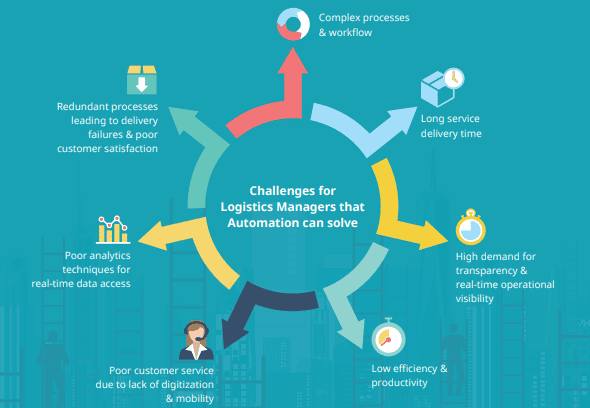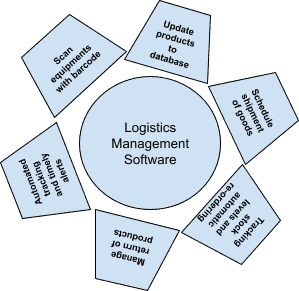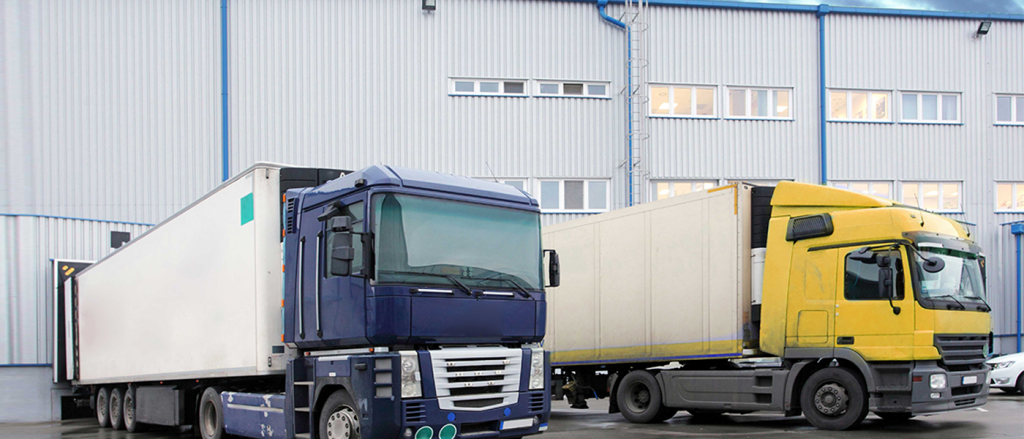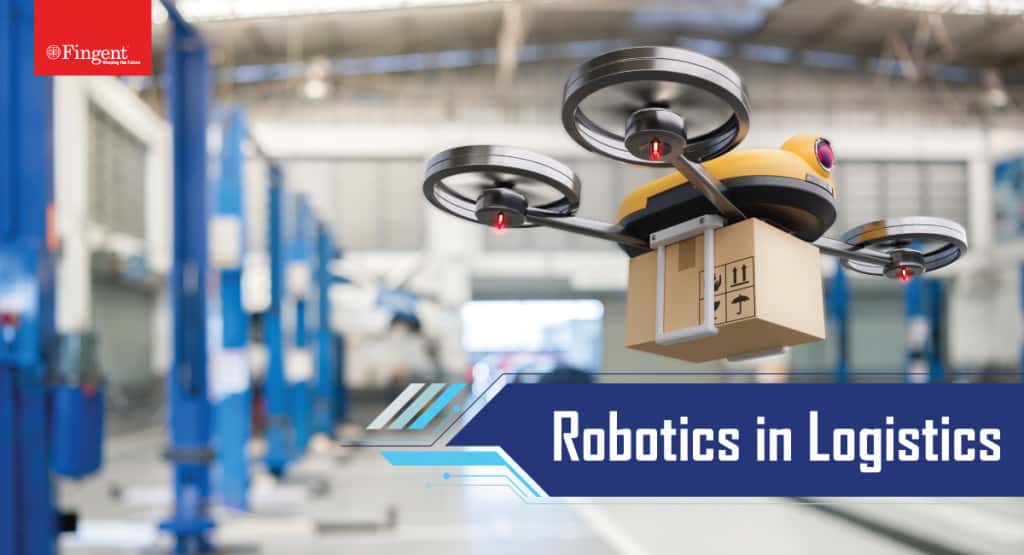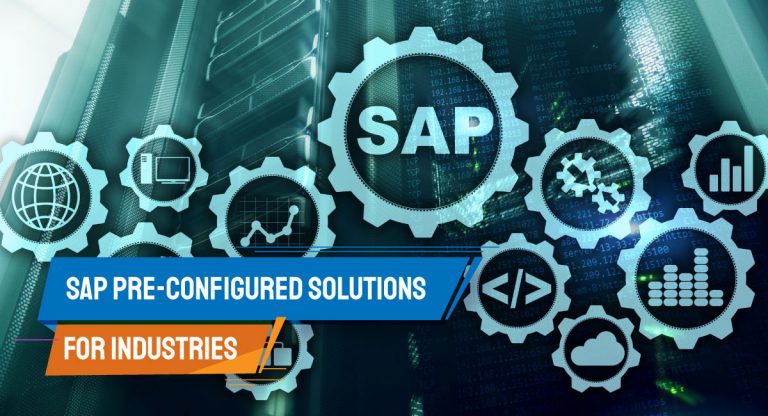Tag: Logistics
Can Cloud based Logistics Platforms help you? The logistics game is changing fast! The industry is under immense pressure to improve its efficiency and reduce costs. That is its one shot at enhancing customer satisfaction. For years, traditional logistics management systems have struggled. Outdated technology slowed their processes. But now, technology brings a game changer for businesses: Cloud based Logistics Platforms!
With these smart systems, your company can get real-time insights and boost scalability. It will help optimize your supply chain to get maximum efficiency. Are you prepared to safeguard your operations for the future? Let’s get started.
What Is the Primary Purpose of Using Cloud Based Collaboration Tools in Supply Chains?
Cloud-based collaboration tools aim to enhance teamwork in supply chains. They let people share information quickly and easily, no matter where they are. This helps teams work together better, make decisions faster, and stay organized. These tools improve efficiency and lower costs.
Supply chains thrive on precision. But when communication slows and data scatters, mistakes happen. Research from Gartner reveals that bad data costs companies an estimated 15% of their revenue, with the average financial impact reaching $9.7 million per year. Here is where cloud-based solutions come into play.
They eliminate silos and bring everyone involved onto the same page. Cloud-based services offer immediate access to data. Logistics companies can prevent interruptions, reduce errors, and make quick, smart choices. They improve supplier collaboration, resulting in reduced bottlenecks and greater overall efficiency.
Struggling With Outdated, Disparate & Disconnected Logistics Systems? It’s Time To Up Your Game with Cloud-based Logistics Platforms!
Top Benefits of Cloud-Based Solutions for Logistics Management
Statistics indicate that many are switching to the cloud. The global cloud logistics market is expected to reach US$ 46,313.9 million by 2030, growing at a rate of 13.6% per year from 2025. This growth shows businesses are recognizing the benefits of Cloud-Based Solutions for Logistics Management. Here are some of those benefits:
-
Real-time tracking and Visibility
The Challenge
Logistics teams often lack information regarding the whereabouts of shipments. This results in setbacks, misplaced packages, and dissatisfied customers.
The Solution
Cloud-based services offer comprehensive shipment tracking featuring real-time GPS information. This gives logistics managers clear insights. It helps them optimize package routes and cut down delays in delivery. It also addresses any kinds of disruptions that we expect on delivery routes. Customers benefit from accurate ETAs and automated notifications. These features help build trust in the brand and boost satisfaction with services.
-
Scalability on Demand
The Challenge
Customer requirements change throughout the year. When demand spikes, logistics systems find it hard to cope with the sudden pressure. They have to scale operations but doing so without incurring large upfront costs becomes difficult to achieve.
The Solution
Cloud-based solutions help businesses to scale their operations easily. You do not need expensive hardware upgrades to achieve that. Cloud platforms can tackle it all. They handle adding fleet vehicles, expanding warehouses, and managing seasonal surges. This lets businesses grow as they need, without the stress of a fixed infrastructure.
-
Cost Savings
The Challenge
Inefficient logistics often lead to high operational costs. This happens due to manual errors, poor route planning, and fuel waste.
The Solution
Say goodbye to unnecessary expenses with cloud-based solutions. These systems provide AI-driven route optimization. Workflows are automated and the system works on predictive analytics. These processes help cut fuel use, reduce human errors, and improve warehouse storage.
Businesses can shift from costly, physical IT setups to affordable cloud services. This change helps free up capital. This lets companies invest in other growth initiatives that will help them over time.
-
Better Teamwork
The Challenge
When warehouses, drivers, suppliers, and customers don’t communicate well, it can cause problems in logistics. This often causes delays in the process.
The Solution
Cloud based logistics platforms integrate communication tools like instant messaging, automated alerts, and shared dashboards. This ensures that all stakeholders remain informed at all times. Enhanced communication results in more effective teamwork, faster reactions, and reduced misunderstandings. This results in a supply chain that is more coordinated and effective.
-
Security and Compliance
The Challenge
Companies deal with sensitive client information on a daily basis. Data breaches, fines, and not following industry rules don’t look good for security. This can put businesses at serious risk.
The Solution
Cloud-based platforms prioritize keeping data safe. They offer strong security features, like encrypted storage and multi-factor authentication. These protect against intruders. Their AI-driven threat detections safeguard sensitive data. Many of these platforms have built-in compliance tools. These tools help logistics companies follow important guidelines. This helps prevent costly violations.
Real-world Success Stories with Cloud Based Logistics
1. Turn Chaos into Control
The Challenge
Shipping companies lose a lot of time and money due to outdated logistics systems. Inefficient tracking systems and fleet management cause frequent delivery delays.
How Cloud-Based Tech Helps
By using a cloud based logistics platform, shipping companies can see their whole fleet in real time. This allows AI-powered route planning and an automated maintenance schedule.
The result? Delivery delays decrease significantly. Fuel use improves and becomes more efficient. Vehicles experience less wear and tear, which leads to substantial cost savings.
2. Warehouse Woes Fixed in E-commerce Giant
The Challenge
E-commerce players face frequent inventory mishaps. There are errors in fulfilment. Increasing order volumes become difficult to keep up with.
How Cloud-Based Tech Helps
A cloud-powered warehouse management system transforms operations by automating inventory tracking. The team can improve demand forecasting and streamline order fulfilment processes as a result. With real-time inventory insights, stock discrepancies drop. A large margin reduces customer delivery times. This helps grow clientele, strengthens brand loyalty and boosts repeat sales.
3. Cold Chain Logistics Enhanced
The Challenge
Global food distribution companies struggle with inconsistencies in temperature during transport. Due to this, many perishable goods are spoiled in transit. These goods cost a significant amount of money, and there are huge financial repercussions. Apart from that, many regulatory issues crop up.
How Cloud-Based Tech Helps
Integrating IoT-enabled cloud tracking helps monitor temperature and humidity in real-time. Automated alerts are sent to drivers and logistics managers. This helps them take quick action. This helps companies comply with food safety regulations and reduce waste.
4. Meeting Customer Demands Efficiently in the Retail Supply Chain
The Challenge
A national retail chain faced issues with delayed shipments and stock imbalances. This resulted in frequent out-of-stock scenarios and lost sales.
How Cloud-Based Tech Helps
A cloud-based supply chain management system enables real-time inventory tracking and automated restocking. An AI-driven forecasting system cuts down stockouts and boosts supply chain efficiency. Stores can keep shelves full, which keeps customers satisfied.
Discover Your Possibilities with Custom Logistics Software Development
How Fingent Helps Logistics Companies Stay Ahead
In today’s fast-paced world, there is no time for errors. Cloud based logistics platforms are a must if you want to stay relevant. Be it real-time tracking or automation and cost savings, the cloud has got your back. It is the key to staying competitive.
Fingent empowers logistics companies to transform their supply chain. We leverage cloud technology, AI analytics, and automation for better results.
We have worked with clients globally helping them reduce internal workloads by 50%, increase their customer base by 43% within 6 months, gain a 60% increase in employee satisfaction and more.
Stay up to date on what's new

Featured Blogs
Stay up to date on
what's new



Talk To Our Experts
Cost, Compliance, Efficiency, and Manpower – These are the pillars on which a fleet management business stands. A compromise on any of these can mean the whole business topples with a resounding crash.
How can you ensure the stability of these pillars? Custom Fleet Management Software brings you the solution. Let us find out how.
Fleet Management and Technology
Before we dive into the many valid reasons why every successful company should have its own personalized fleet management software, let us first familiarize ourselves with what fleet management is.
Fleet management is a service that helps businesses that rely on transportation remove or limit the risks associated with vehicle investment, enhance efficiency and productivity, and decrease total transportation and labor expenses. While most typically used for vehicle tracking, fleet management also involves monitoring and documenting mechanical problems and driver behavior.
In addition to a 12% increase in fleet management technology usage between 2019 and 2020, forecasts indicate that the fleet management market was valued at $25.5 billion in 2022 and might grow to $52.4 billion by 2027.
Fleet efficiency is by far the most important and game-changing aspect of fleet management. It refers to the economic feasibility and optimal functioning of the entire fleet, irrespective of the vehicles in it. If you can lock down the efficiency of your fleet, you will be one step ahead of other businesses. This makes improving fleet efficiency a top priority for companies.
Read more: Robotics in Logistics: Dawn of a New Era
Fleet Management Challenges
Just like shop-floor machinery and equipment, fleet vehicles have their fair share of obstacles. The top three are:
- Driver Shortage: The shortage of drivers has been one of the top issues for fleet managers over the last decade. Recruiting drivers with little driving experience can also result in safety concerns and the additional requirement for driver monitoring strategies.
- Safety: Accidents are not only costly and result in injury or even serious hospitalization, but they also harm production, profitability, and reputation.
- Handling High Costs: The most significant obstacle to fleet management will always be cost control. It’s critical to do a complete analysis of your present operations and focus on areas that require improvement, such as driver behavior, fuel prices, possible theft, and CO2 emissions.
How Does Fleet Management Software (FMS) Help Tackle These Challenges?
Effective fleet management software is a perfect solution for these top three challenges faced by most companies, here’s how:
- Technology can aid in monitoring driver responses and safety practices. Intelligent systems are able to analyze and extract meaning from the data. Additionally, deviations in data that might indicate future issues can be found using predictive analytics. They can serve as early warning systems and aid in hiring qualified drivers for the position.
- A fleet management system can track a driver’s hours of service and shifts performed, which can help reduce the risk of accidents. It can also monitor a driver’s training and experience to guarantee they are matched with a vehicle.
- Although it can seem impossible to overcome increased expenses, operating more economically and efficiently is now feasible thanks to advanced technological solutions. Your fleet operations can be improved by implementing an AI-powered solution or fleet management software.
Benefits Of FMS
Here are the key advantages of a well-primed fleet management system:
- Improved customer satisfaction that comes with orders and services being on schedule.
- You can manage your whole fleet from one location using FMS, giving you access to a single, user-friendly platform.
- Technology-based solutions periodically yield unexpected insights about managing fuel use. They enable you to get notifications and updates, such as when a certain vehicle is about to go over the daily distance allotted.
- There are built-in capabilities in the software that let you drive less and use less gasoline, which cuts down on expenses significantly.
- Customer wait times, maintenance expenses, and fuel costs may all be decreased with the use of route optimization.
Some of the other benefits include thorough and well-structured reporting and analytics, prevention of theft and fraud, and improved vehicle lifespan.
How Is Customized Fleet Software Better Than Fleet Management Off-The-Shelf Software?
When dealing with software and technology in general, it is always better to opt for a more personalized service rather than ordinary, pre-developed software. Though it might seem to cost more and take longer to produce, custom software provides specialized solutions, scalability, and a competitive edge. A custom FMS is made especially for the firm and tailored to its specific business practices.
According to 87% of IT decision-makers questioned, corporate technology innovation is being driven by custom software. Pre-packaged software is less likely to be used than bespoke software, according to half of the respondents (52 percent).
A custom FMS can provide a level of flexibility to your solution that has the power to make all your business processes flow seamlessly. As a business owner, it is part of your responsibility to ensure that whatever investment you make in the company can survive in the long run. Customized software for fleet management is one such investment. It is definitely worth it in the long run.
Myths Revolving Around Custom FMS Development
Most evolving technologies suffer at the hands of myths and rumors of inefficiency. This leads to uncertainty and hesitation towards developing a custom solution. Let’s address some of those myths associated with custom FMS development:
- A GPS Tracker And Fleet Management System Are the Same Thing: This is untrue. GPS tracking is one of the many components of FMS. There are many other beneficial components of the software.
- Customized Software Is Not Scalable: On the contrary, custom software is more scalable than off-the-shelf. With the right software partner, the software can be designed to be scalable – you only pay how much your business needs and then add to it as the business expands.
- Small-Fleet Businesses Do Not Benefit from A Fleet Management System: Regardless of the size of the business, they usually require a fleet of vehicles, a number of drivers, and logistic hassles that come with them. Fleet efficiency is paramount if a business wants to have a competitive edge in the market, especially for small businesses vying for a spot with big players. This makes Fleet Management Software all the more necessary.
- Fleet Management Systems Violate Drivers’ Privacy: It becomes crucial for fleet managers to clarify to drivers that the purpose of using fleet management technologies is to increase overall process efficiency, not to violate an individual’s privacy.
How Can Fingent Help?
Fingent works with clients globally to develop custom software for their many logistical operations, including fleet management. By incorporating technologies like IoT, cloud computing, robotic process automation, big data, and blockchain, we bring you the efficiencies that they provide. This includes real-time data visibility, automation of tedious tasks, intelligent tracking of road conditions, and more.
Our tech experts will work with you to provide a custom solution that will meet your specific business needs, with the ability to scale as your business grows.
Give us a call, and let’s discuss how we can make this possible.
Stay up to date on what's new

Featured Blogs
Stay up to date on
what's new



Talk To Our Experts
Artificial Intelligence (AI) evolved from a concept of science fiction to a transformative force that permeates our daily lives. From autonomous vehicles to voice assistants, AI has already made significant inroads in various sectors.
However, one area that stands to gain immensely from AI’s potential is the supply chain. As the backbone of global trade, the supply chain encompasses complex networks and intricate logistics. It is an ecosystem where efficiency, accuracy, and agility can make or break success.
With its vast array of applications, AI has the potential to streamline operations, enhance decision-making, and unlock untapped opportunities. In this journey through AI’s rising capabilities, we will delve into real-world use cases that demonstrate how AI is revolutionizing the supply chain. Furthermore, we will also explore the specific benefits that AI brings to the supply chain domain.
Role Of AI Optimizing the Supply Chain
Every business owner dreams of a supply chain that is finely tuned, seamlessly efficient, and adaptive to every twist and turn of the market. A business where warehouses run like clockwork, shipments arrive precisely on time, and customer demands are anticipated with uncanny accuracy is not a far-fetched dream; it’s a reality being shaped by the game-changing role of Artificial Intelligence (AI) in optimizing supply chain operations.
At the heart of AI’s transformative influence are three key components that work in harmony to revolutionize the supply chain landscape. Let’s uncover their captivating role in reshaping the future of supply chains.
- Machine Learning and Predictive Analytics: Machine learning and predictive analytics in the supply chain are like having a trusted, experienced mentor by your side, whispering valuable insights and guidance into your ear. Machine learning algorithms analyze vast amounts of historical data to uncover patterns, trends, and potential pitfalls.
- Natural Language Processing and Chatbots: Natural Language Processing (NLP) allows you to simply ask a question about your supply chain and receive instant, accurate answers. With a chatbot available 24/7, customers can get instant responses, while supply chain teams can focus on strategic decision-making.
- Robotics and Automation: Robots, equipped with advanced sensors and AI algorithms, can perform repetitive tasks with unmatched precision and speed. From inventory management to order fulfillment, these tireless machines streamline operations, reduce errors, and enhance efficiency.
How AI Solves Supply Chain Challenges
The world of supply chain management is like a complex maze with numerous challenges at every turn. Thankfully, AI emerges as the trusty guide, equipped with the tools to solve some of the most daunting hurdles. Here are some for your reference:
1. Demand Forecasting and Inventory Optimization: This AI-powered assistant acts as your supply chain ‘savant,’ it understands your historical consumption patterns, market trends, and even factors like seasonality or promotional events.
2. Supplier Selection and Relationship Management: Choosing the right suppliers and maintaining strong relationships is like finding the perfect dance partner. AI steps in as a knowledgeable matchmaker. By analyzing vast amounts of supplier data, performance metrics, AI algorithms can assess and rank potential suppliers based on criteria such as reliability, quality, and cost.
3. Warehouse and Inventory Management: AI acts as a vigilant warehouse manager, optimizing layout, guiding picking and packing processes, and even predicting optimal storage locations. With AI-powered systems, warehouses can maximize space utilization, minimize errors, and accelerate order fulfillment, resulting in streamlined operations and satisfied customers.
4. Transportation and Logistics Optimization: AI takes on the role of coordinator who has a bird’s-eye view of the entire transportation network, utilizing algorithms to analyze real-time data on factors like traffic, weather conditions, and delivery constraints. By optimizing routes, load planning, and vehicle assignments, AI enables efficient transportation management.
5. Quality Control and Defect Detection: Think of a diligent quality inspector who never misses a flaw in a product. AI becomes this meticulous inspector, utilizing computer vision and machine learning algorithms to analyze visual data and detect defects with remarkable accuracy.
6. Risk Management and Supply Chain Resilience: AI plays this vital role just like a risk management expert. It analyzes a wide range of data sources to identify potential risks and vulnerabilities, ensuring supply chain resilience in the face of uncertainties.
7. Customer Service and Satisfaction Enhancement: AI takes on the role of a customer service representative who can swiftly address customer inquiries, provide accurate information, and resolve issues with ease. AI-powered customer service tools offer instant responses, personalized recommendations, and seamless assistance, enhancing customer satisfaction and loyalty.
Watch: Artificial Intelligence – how to navigate AI if you are not a tech company.
Remarkable Real-world examples of AI in the Supply Chain
AI transforms supply chain management like never before. Don’t take our word for it. See it in action as implemented by big players in the industry:
Use Case 1: Precision Prediction by Amazon
Problem: Traditional demand forecasting and inventory management methods often struggle to predict customer demands and optimize inventory levels in real-time accurately.
Solution: To address this challenge, Amazon has harnessed the power of AI algorithms to revolutionize demand forecasting and inventory management. By analyzing vast amounts of customer data, historical sales patterns, and even external factors like weather forecasts, AI algorithms can accurately predict demand with remarkable precision.
This AI-driven approach allows Amazon to optimize inventory levels, ensuring that popular products are readily available while minimizing excess inventory and reducing the risk of stockouts. By aligning supply with demand, Amazon is able to enhance customer satisfaction and maintain a competitive edge in the dynamic e-commerce landscape.
Use Case 2: Substitution Solution by Walmart
Problem: In online grocery shopping, customers often encounter situations where certain items they ordered are out of stock. This can lead to dissatisfaction and inconvenience, as customers may have to manually search for suitable substitutes or go without the desired product.
Solution: To address this issue, Walmart has implemented an AI-driven product substitution system. Using advanced algorithms, the system analyzes product attributes, customer preferences, and available inventory data to suggest suitable substitutions for out-of-stock items.
When an ordered item is unavailable, the AI system automatically identifies the best possible substitute based on factors such as brand, size, price, and customer feedback. It takes into account the customer’s past purchase history and preferences to make personalized recommendations. The system provides clear and transparent information to customers, ensuring they are aware of the substitution and have the option to accept or reject it.
Use Case 3: Real-Time Routing by UPS
Problem: Traditional route planning methods often struggle to optimize delivery routes efficiently, resulting in inefficient use of time, resources, and fuel.
Solution: UPS leverages AI algorithms for route optimization, enabling them to analyze real-time data on factors such as traffic patterns, delivery constraints, and even weather conditions. By considering these variables, UPS can generate optimal delivery routes that minimize distances, reduce fuel consumption, and optimize delivery time.
Through the implementation of AI in its logistics operations, UPS achieves significant cost savings, improves delivery efficiency, and reduces its carbon footprint. This AI-driven approach allows UPS to stay ahead of the competition and provide exceptional service to its customers.
Use Case 4: Valuable Vending by Coco-Cola
Problem: Traditional vending machines often lack the ability to gather real-time data on customer behavior and gauge the effectiveness of different brands and product offerings.
Solution: To overcome these limitations, Coca-Cola has implemented AI-enabled next-gen vending machines. These machines are equipped with advanced sensors, cameras, and AI algorithms that gather real-time data on customer behavior, purchasing patterns, and brand preferences.
With this newfound understanding, Coca-Cola can optimize product placements, tailor offerings to specific locations, and develop targeted marketing campaigns. Furthermore, the AI-enabled vending machines also allow Coca-Cola to remotely monitor inventory levels, predict demand patterns, and optimize restocking schedules. This ensures that the vending machines are always well-stocked with popular products, reducing the likelihood of stockouts and maximizing sales opportunities.
Use Case 5: Wonder Warehouses by Alibaba
Problem: Traditional warehouse management practices often face challenges related to inefficient storage utilization, suboptimal picking processes, and delays in order fulfillment.
Solution: Alibaba has embraced AI technology to develop smart warehouses that leverage automation, robotics, and AI algorithms. These AI-enabled warehouses optimize storage utilization, streamline picking and packing processes, and enable efficient order fulfillment.
Through the integration of AI, Alibaba achieves faster and more accurate inventory management, enhances warehouse operations, and improves overall efficiency in its supply chain. This innovative use of AI allows Alibaba to meet the demands of the e-commerce market and deliver exceptional service to its customers.
Checkout out our Infographic: Successful Logistics and Warehouse Management Practices.
Solid Supply Chain Solution with AI by Fingent
Advancements in AI technologies continue to shape the supply chain landscape, with machine learning algorithms becoming more sophisticated, natural language processing capabilities evolving, and robotics and automation becoming increasingly intelligent and adaptable. These advancements enable businesses to make data-driven decisions, automate repetitive tasks, and optimize operations like never before.
At Fingent, we understand the immense potential of AI in supply chain management and are committed to helping businesses harness its power. Our expertise lies in developing innovative AI solutions tailored to specific industry needs, integrating AI with emerging technologies, and driving digital transformation in the supply chain.
Whether it’s building intelligent forecasting models, implementing AI-powered automation, or leveraging AI-driven analytics, Fingent is dedicated to empowering organizations to thrive in the AI-driven supply chain landscape.
Businesses that embrace its potential will gain a significant competitive advantage. By leveraging AI technologies, integrating with emerging technologies, and partnering with experienced custom software solution providers like Fingent, organizations can unlock new frontiers of efficiency, innovation, and success in the dynamic world of supply chain management.
Reach out to us to get the best supply solution for your business.
Stay up to date on what's new

Featured Blogs
Stay up to date on
what's new



Talk To Our Experts
SAP S/4HANA is a catalyst for business success, weaving its transformative power across the ERP landscape. SAP S/4HANA is more than just any software; it’s a realm of possibilities. It is like a digital fortress that integrates and orchestrates your supply chain, ensuring harmony and efficiency throughout your organization.
With a single source of truth, it empowers organizations to make informed decisions based on accurate, up-to-the-minute insights. It’s like having a trusted compass that illuminates the hidden paths of your operations, empowering you to confidently navigate the ever-changing terrain of the business landscape.
Understanding SAP S/4HANA – A Visionary Leap Into The Future
SAP S/4HANA is not your ordinary ERP solution. It harnesses the power of in-memory computing, real-time analytics, and a simplified data model to deliver a seamless and intelligent ERP experience. It is a technological marvel that blends speed, agility, and simplicity into a single transformative platform.
The shift from traditional SAP ERP systems to SAP S/4HANA marks a significant milestone in the ERP landscape. It represents a move from a row-based data model to an in-memory, columnar-based data model, resulting in lightning-fast data processing and real-time analytics.
With the transition to SAP S/4HANA, businesses unlock a plethora of benefits. They gain real-time insights for faster decision-making, simplified processes for improved efficiency, and intelligent technologies for enhanced automation and predictive capabilities. It’s like upgrading to a futuristic command center that propels your business into a new realm of success.
Let’s begin by unveiling the key features and capabilities that make SAP S/4HANA shine.
- It brings the power of real-time insights, allowing businesses to make decisions based on up-to-the-minute data.
- SAP S/4HANA simplifies processes, reduces data redundancies, and eliminates complexities to streamline operations.
- It leverages advanced technologies such as artificial intelligence (AI), machine learning, and predictive analytics to unlock automation, insights, and predictive capabilities.
Read more: A Beginner’s Guide To Implementing SAP S/4HANA
Key Benefits of SAP S/4HANA
1. Grasp The Pulse of Your Business at Any Given Moment with Real-Time Analytics.
With its in-memory computing capabilities, SAP S/4HANA processes massive amounts of data in real-time, allowing for faster and more responsive operations. With real-time analytics, you have the power to respond swiftly to changing market dynamics, identify emerging trends, and seize opportunities before they fade away. It’s like having a nimble and swift chariot that propels your business forward, helping you stay ahead of the competition.
2. Enthralling User Experience
SAP S/4HANA’s intuitive interface and personalized dashboards transform ERP navigation into a delightful journey. It’s like stepping into a realm of effortless elegance, where tasks are completed with grace and efficiency, where your teams can work seamlessly, unlocking their full potential and driving productivity to new heights.
3. Declutter Your Landscape with a Simplified Data Model
SAP S/4HANA can help you bid farewell to the tangled webs of complexity and data redundancies. It enables you to declutter your business landscape, allowing you to focus on what truly matters—innovation and growth. With a simplified data model, your organization gains agility, flexibility, and the ability to adapt swiftly to changing business needs.
Now that you are aware of the business benefits let’s discuss how you can prepare for SAP S/4HANA implementation.
Prepare For SAP S/4HANA Implementation
With the right foundations in place, organizations can embark on their SAP S/4HANA implementation with confidence, ready to unlock the full potential of this transformative platform.
1. Assessing Business Readiness:
Assessing the organization’s readiness for SAP S/4HANA implementation is like taking stock of your supplies before embarking on a grand expedition. Evaluating data readiness ensures that your information is accurate, complete, and compatible with the new system. Additionally, allocating resources appropriately – including skilled personnel and budget – ensures that you have the necessary support to navigate the implementation journey smoothly.
2. Building the Implementation Team:
On a voyage, each member has a vital role to play. Project managers steer the entire implementation process. Functional consultants bring their expertise in specific business areas, ensuring that SAP S/4HANA meets your unique requirements. Technical experts handle system configurations, integrations, and customizations. Together, this cross-functional team brings together diverse perspectives, fostering synergy and ensuring that all aspects of the implementation are addressed comprehensively.
3. Chart your Course by Defining Implementation Goals and Scope:
Defining clear goals and scope for the SAP S/4HANA implementation provides a clear direction and prevents aimless wandering. By identifying key business processes, you prioritize areas that will benefit most from the new system. This focused approach optimizes time and resources enabling effective project planning and increasing the likelihood of a successful SAP S/4HANA implementation.
Six Phases of SAP S/4HANA Implementation
Each of the following well-defined phases of the SAP S/4HANA phase brings your organization closer to harnessing its and unlocking new levels of efficiency, agility, and competitive advantage:
Phase #1 Project Planning and Preparation:
Planning and preparation are like laying the foundation for a solid structure. Activities in this phase include creating a detailed project plan, establishing timelines, and defining deliverables. By clearly outlining project objectives, tasks, and responsibilities, organizations ensure a structured and well-organized implementation process.
Effective stakeholder communication is vital during this phase, keeping everyone informed and engaged. Change management strategies are implemented to address any resistance to change, ensuring the smooth adoption of SAP S/4HANA.
Phase #2 System Installation and Configuration:
System installation and configuration start with assessing hardware requirements and designing the system landscape, ensuring optimal performance and scalability. The SAP S/4HANA system is then installed, configured, and integrated with other systems, creating a cohesive IT ecosystem. This phase requires careful consideration of factors like network infrastructure, security, and software installation.
Phase #3 Data Migration and Conversion:
Data migration and conversion are like transferring belongings to a new home. Legacy data is extracted, transformed, and loaded into the SAP S/4HANA system. This process involves data cleansing, eliminating duplicates, and ensuring data accuracy. Data validation is crucial to verify the integrity and consistency of migrated data.
Phase #4 Customization and Configuration:
This phase is like arranging furniture in a new space. Configuration involves setting up master data, defining workflows, and configuring system functionalities. This phase ensures that SAP S/4HANA aligns with the organization’s unique processes, enabling efficient operations and improved user experience.
Phase #5 Testing and Training:
Testing and training form the backbone of a successful SAP S/4HANA implementation. Thorough testing is conducted to validate the system’s functionality, performance, and data accuracy. This includes unit testing, integration testing, and user acceptance testing.
Training programs are designed to equip end-users with the necessary skills and knowledge to effectively utilize SAP S/4HANA.
Phase #6 Go-Live and Post-Implementation Support:
Going-live is like opening the doors to a new facility, enabling users to work with real data. Post-implementation activities include monitoring system performance, addressing user feedback, and providing ongoing support. Continuous improvement initiatives and enhancements are implemented based on user experience and evolving business needs. Regular system maintenance and updates ensure the system’s optimal performance and long-term success.
These are some best practices and lessons learned from previous SAP S/4HANA implementations. They offer valuable insights that can guide your organization toward successful implementation. These can help you avoid common pitfalls and maximize the benefits of SAP S/4HANA.
Read more: A Simple Guide To Handling Common SAP Errors and Troubleshoots
Strategies You Can Use to Overcome Common Challenges
Challenges during SAP S/4HANA implementations can vary, but some common ones include data migration complexities, resistance to change, resource constraints, and technical integration issues. To overcome these challenges, organizations should:
- Engage experienced consultants and leverage their expertise.
- Invest in data cleansing and migration tools to streamline the process.
- Prioritize change management activities and communicate the benefits of SAP S/4HANA.
- Allocate sufficient resources and budget for implementation and post-implementation support.
- Collaborate closely with SAP experts and leverage their guidance and best practices.
- Monitor the implementation progress regularly and adapt the plan as needed.
How Can Fingent Help?
Fingent can provide comprehensive services to deploy SAP S/4HANA for better supply chain management. We at Fingent offer consulting services to assess your supply chain management requirements and design a customized SAP S/4HANA implementation strategy. Our advisory services provide expert guidance on how to optimize your operations and drive digital transformation.
Are you currently using an older version of SAP ERP? If so, we can analyze your existing system, assess the impact of the conversion, and guide you through the conversion process.
Fingent leverages SAP Leonardo’s intelligent technologies, such as machine learning, IoT, and analytics, to enhance your supply chain management processes. With our expertise in SAP S/4HANA and supply chain management, we can guide you through the entire deployment process, from strategy and implementation to ongoing support.
Reach out to us, and let’s work magic for you.
Stay up to date on what's new

Featured Blogs
Stay up to date on
what's new



Talk To Our Experts
The onset of globalization has encouraged business operations on an international scale. It offers companies the opportunity to reach new customers in new markets. Exposure to unknown markets and sometimes even known markets can expose businesses to greater competition and greater risk. However, efficient management of the supply chain can do away with many of these risks and put you on the path to success.
The challenges in the supply chain can include being unsure of the reliability of your suppliers, and their quality, cost, lead time, lot size, and more. Your business will surely profit if you had a way to monitor your supplies and the risks to your business.
Yes, clear visibility is crucial.
This is where custom software can benefit your business!
Custom software equips you with a way to collect, organize, and monitor the supplier-related information that is most meaningful to your business. This blog discusses which functions of the supply chain can be better managed with custom software and also talks about the benefits this can bring to your business.
Why Is Customized Supply Chain Management Software Important?
Efficient management of the supply chain depends primarily on data gathered at each stage of the supply chain process. The success of the business hinges on the way companies use those insights to make decisions that optimize demand, supply, inventory, and deliveries.
That is why custom software is essential to managing the supply chain. Custom software can enable organizations to make better use of their data as it gives structure to the information already in their possession.
Through the use of custom software solutions, companies can identify faults in their supply chain process. Such visibility can help them make better inventory decisions or inform their customers of the shipping status for their confirmed orders.
Essentially, custom software is instrumental in improving business operations and relationships with both customers and suppliers.
Read more: Build or Buy Logistic Software: An End To The Prolonged Discussion
Manage Key Supply Chain Functions with Custom Software
Every business is unique in its functions. A software can address the specific company challenges only when customized and tailor-built after crucially analyzing the workflows and industry pain points. Here are a few to look into.
- Raw material acquisition: Supply chain management is a journey, and purchasing is at the beginning of that journey. Purchasing includes sourcing raw materials and other resources. Custom software enables smooth coordination with suppliers to deliver the material without any delays requires.
- Planning and forecasting: The operations team must anticipate the possible market demand and the number of units for production. Over-anticipated demand can result in excess inventory costs. If it is underestimated, then the company will not be able to meet its customer demand and thus lose revenue. Custom solutions for planning and forecasting can help the operations team to anticipate demands more accurately.
- Warehouse arrangement: Supply chain management requires warehouse arrangements till it is shipped for delivery. If the products are delivered outside the country or state limits, there will also be a need for outstation warehouses. Custom software can optimize logistics to reach end-point delivery without any glitches.
Advantages Of Custom Software in Supply Chain Management
1. Increased transparency throughout the supply chain
Knowing exactly where your item is at any given time is important for all businesses as it allows you to sell the item before it even reaches your warehouse. Custom software can help you sell this way because it can pinpoint the exact location of your item and the time that it will reach your warehouse.
This will allow you to provide a guarantee to your customer that he will receive the product he purchased. Streamlining the supply chain will help achieve faster response times and increase customer loyalty.
2. Efficient inventory management
With the help of custom software, you can sell your item while it is on the move or as it is in the making. It can help you estimate how many items you must produce, eliminating excessive production.
3. Supplier management
You can keep a good relationship with your suppliers with custom software. Real-time data will allow you to know if you are running out of stock or if your tools and equipment need repair or replacement. This data will help you contact your suppliers immediately and thus minimize any potential delays.
You will also have details such as account receivables and other information at your fingertips when dealing with your suppliers. This will ensure that you are up to date with payments and discounts. As a result, you notice that your communication and cooperation with dealers and vendors improve considerably.
4. Streamline Processes
Custom software will create highly streamlined processes for supply chain management, especially for businesses that operate from different locations across the globe.
Fully customized software enables companies to accumulate all business data in one centralized location. Employees greatly benefit from this as they can now gain access to the latest versions of data, even if they are accessing it from multiple locations or branches.
5. Un-bottleneck your supply chain
Bottlenecks in the supply chain are a direct result of the ineffective system in place that does not allow teams in different locations to communicate and align statuses to fulfill overall objectives. Companies that experience such bottlenecks miss opportunities and lose customers because they are unable to provide what their customers want.
An unsatisfied customer walks out on you and straight into the open arms of your competition. If you are beginning to notice lower satisfaction rates, numerous complaints, or bad reviews from the customers, it is time to explore custom software that can give you a business-targeted approach to customer experience.
When a business looks to meet or exceed customer demands, they have to rely heavily on its supply chain. Internal bottlenecks can slow down the entire process and risk order fulfillment. To prevent such bottlenecks, a business must understand what causes them and how to prevent them.
Custom software can help a business identify such bottlenecks and thus help efficiently manage the supply chain.
Save Money, Time, and Your Business!
It is clear that custom software comes with many benefits. It is also obvious that it saves money with time. While off-the-shelf software may come with a lower initial cost, investing in custom software will give more benefits to the supply chain management cycle. It improves sales functions and boosts productivity.
Custom software that is fully optimized to the supply chain will improve business function in a way no off-the-shelf software can. Fully optimizing the supply chain process can be lean and seamless through the use of custom software. If the business growth process is left unchecked by the off-the-shelf software solutions it can become highly chaotic. Custom software gives companies a higher level of control over all supply chain operations while taking control over the growth process.
A company that is digitally driven by custom software automatically enables a more proactive and open business. If this is what you want for your business, give us a call.
Our experts at Fingent thrive on creating custom solutions for our clients. They will be happy to talk through the game plan with you and show you how your business can excel with custom software for your supply chain.
Stay up to date on what's new

Featured Blogs
Stay up to date on
what's new



Talk To Our Experts
The COVID-19 pandemic has created an imbalance between the supply and demand of the goods thereby disrupting the supply chain globally. That said, it has also amplified the need for technology tools to manage the supply chain challenges as the possibility of lockdowns in the future can’t be overlooked.
With the increasing demand for autonomous solutions, it is not surprising to see companies investing in supply chain technologies. According to Gartner, by 2023, 50% of the global eCommerce companies will invest in the real-time supply chain, AI, and advanced analytics solutions.
Challenges in the Supply Chain
1. Labor and material shortages
2020-21 witnessed several layoffs and quarantine putting the market in flux globally. Leaders not only face delegation woes but also find staffing key positions within procurement and supply chain ops problematic. Leaders will have to rely on technologies and automation to create cohesion and shift focus to smaller more concentrated procurement teams.
According to the Institute of Supply Chain Management report, every key commodity is either scarce or up in price leading to shortages and complexities to supply chain management. In other words, the material shortage will continue and companies can expect persistent problems through 2022.
2. Rising freight costs
In 2021, trucking and intermodal transport shot to new highs while spot prices doubled across the board: van (+18%), reefer (+25%), flatbed (+27%). Additionally, sea freight price and air freight price skyrocketed as well making it difficult to move freight in any capacity.
Thus, fluctuation in freight price will remain one of the biggest challenges the supply chain industry will have to face in coming years.
3. Port congestion
In the last two years, there have been wait times for ships headed into ports across the world. In October 2021, over 50 container ships were amassed outside Los Angeles and Long Beach to unload cargo from China. That said, gridlock especially at overseas ports creates delays as ships look to obtain cargo. So, bottlenecks at both ends cause additional lead time for import-export operations ultimately disrupting the domestic supply chains.
While port congestion isn’t a new problem, according to The National Customers Brokers & Forwarders Association of America (NCBFAA), 2022 could see historic wait times and supply chain bottlenecks.
4. Problems related to demand forecasting
While the global shutdown in 2020 skewed supplier data to a great extent, 2021 saw some recovery making the data relatively unreliable as a standard for future forecasting. This has resulted in no proper benchmark for supply chain leaders to follow.
As the unprecedented demand grows, meeting it remains a challenge. So, supply chain leaders will have to rely on trending data to predict the year considering the previous benchmarks for everything from inventory to budget and pricing.
Read more: Logistics Management Software – Everything You Need To Know!
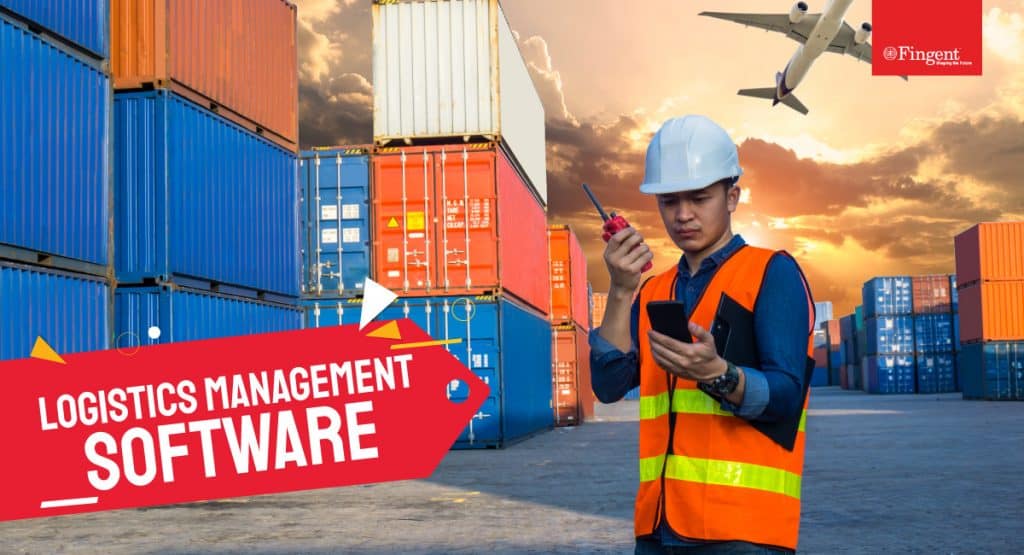
While this adjustment is completely different for those who rely on the last two to three years trailing data to estimate demand forecasting, it is a challenge that requires forethought.
Here are five technologies that will help advance your business in 2024:
1. Robotic Process Automation (RPA)
According to Deloitte, RPA will see strong growth in the next five years specifically in the supply chain operations that include lower-value, potentially dangerous, or high-risk tasks. Robotic technology applications include trains and trucks, automated vehicles like drones, last-mile deliveries, and storage and retrieval systems (ASRS).
The use of RPA can achieve the following objectives:
- Improve productivity and efficiency
- Reduce re-work and risk rates
- Increase employee safety
- Perform repetitive and mundane tasks so humans can work more useful tasks
- Increase revenue by improving order fulfillment and delivery speed
New pricing structures are helping companies consider investing in automation. That said, the RaaS (Robotic and a Service)-type model allows providers to lease units through a monthly service contract instead of customers paying a huge capital up-front.
2. Cloud computing and AI
As supply chains generate big data, cloud-based AI can be used to turn that data into insights. Cloud computing along with AI has transformed the way the supply chain operates and in near future its abilities will only grow in complexity.
Cloud and AI systems can use past trends and market indicators to achieve the following processes;
- Powering automation process
- Informing supplier selection
- Providing real-time information on shipments
- Analyzing carrier performance
- Streamlining supplier onboarding and automating supplier management
- Anticipating trends in operational issues
- Augmenting customer support
Read more: How to accelerate your business growth with Robotic Process Automation
3. IoT
Asset tracking through IoT will help save time and money and assist data-driven decision-making.
Through GPS tracking of shipments and monitoring parcel conditions, IoT devices have improved quality management in the supply chain. RFID chips, mobile sensors, and smart devices can track and authenticate products, humidity, light levels, measure temperature, handling, movement, speed, and other environmental factors of shipments.
Additionally, IoT facilitates new fleet management solutions development which helps improve workflows and customer satisfaction. Also, IoT in the future will reduce the total cost of ownership and make the entire supply chain industry more connected, driven by legislation and customer demand.
Adoption of IoT will also improve security and decrease the probability of piracy, disruption of refrigeration, and container damage.
4. Blockchain
Emerging technology in the supply chain industry, blockchain’s decentralized digital ledger can help improve transparency for customers. This will enable them to track the whole journey of a product before arrival. Additionally, blockchain can increase transparency in audits and improve security by revealing any attempted fraud. Blockchain can help increase the level of trust and make digital payments more secure.
Blockchain systems can also save time and money due to better coordination of documents and eliminate the need for physical paperwork.
5. Transportation Management System (TMS)
All of the above-mentioned technologies need to be organized and managed from a single point. That is where TMS applications complications come into the picture.
TMS is used to manage carriers, and help convert paper-based documentation into a digital format. It will reduce freight costs, track deliveries in real-time, and increase transparency which will eventually improve customer service. Simply put, TMS will help make all the separate elements work as a single system.
TL Nika Logistics is a prime example of successful TMS adoption.
Final thoughts!
There’s no denying that technological innovation is propelling supply chain management solutions. If you are looking to embark on this technical journey, Fingent custom software development experts is the right partner for you. We understand the latest advancements in supply chain technology and help organizations adopt these emerging solutions while gradually replacing legacy systems to help navigate better in this competitive business landscape.
Connect with us today!
Stay up to date on what's new

Featured Blogs
Stay up to date on
what's new



Talk To Our Experts
Stay up to date on what's new

Featured Blogs
Stay up to date on
what's new



Talk To Our Experts
How can companies step up their game and deliver the COVID-19 vaccine efficiently?
The COVID-19 vaccines have received Emergency Use Authorization in the United Kingdom, the United States, Canada, the EU, and a few other countries. Many frontline workers and even the priority population have already received their first doses. Vaccines from several major global manufacturers like India are also set to arrive and be distributed for administration globally.
However, in certain places, the vaccine effort has hit a few roadblocks. Deployment to vulnerable countries and the at-risk group is also slow. As the COVID-19 vaccine is being made available, supplying the doses efficiently with utmost care will be the ultimate logistics challenge. Massive volumes have to be handled, stored through cold chains, and distributed. All processes need to comply with safety regulations. In other words, the vaccines should be distributed quickly and safely worldwide.
In the United States, several organizations play a crucial role in vaccine deployment by adapting their operations to meet the demands. Suppliers, manufacturers, and regulators are stepping up the production of vaccines. Additionally, several thousands of medical, pharmacy staff, frontline workers, and vaccine handlers attend training sessions to understand the peculiarities of different manufacturers’ specific vaccines.
Here, we have discussed seven steps that organizations must engage in to ensure the safe delivery of the COVID-19 vaccine. Following these steps can boost the productivity of your logistics business and efficiency on your future orders and deliveries.
Read more: 6 Tips for Logistics and Supply Chain Leaders to Plan COVID-19 Vaccine Distribution Strategies
1. Ensure raw-materials supplies
Vaccine producers can partner with global suppliers of raw materials and provide support to create redundancies wherever needed in the supply chain. Last year, many manufacturers established new partnerships. However, a wide diversity of suppliers is necessary to meet the demands of each vaccine seeking approval. Manufacturers can negotiate contracts and offer incentives to suppliers who invest in boosting production and stocking-up the goods. Also, producers can evaluate their inventory management and check for stock-outs of essential raw materials.
2. Collaborate with the government
In addition to the above point, the producers must have sufficient interaction with the government to increase production and maintain it. Many manufacturers and suppliers are working closely with the government to manage natural resource allocation. This collaboration must be continued over the economic and public health implications of outsourcing legacy products and optimize production lines for COVID-19 vaccines. Additionally, producers can collaborate with the government to create technology-transfer timelines and develop innovative ways to push bulk volumes to the market. It also helps improve inventory management and distribution.
3. Boost manufacturing by adhering to quality guidelines
As producers need to ramp-up operations in new or existing manufacturing facilities, they could look for opportunities to accelerate the process. Companies can use several digital and analytics tools to expand capacity and scale faster. Additionally, they can accelerate technology transfer time. For example, companies grow and speed up production by conducting engineering runs, validation runs, and stability studies simultaneously.
By collaborating with regulators and manufacturers, authorities can ensure that they meet the established and newly issued guidelines related to the dosage quality and procedures. With such coordination and understanding, higher throughput can be achieved. Similarly, stakeholders can collaborate and employ novel technology platforms such as mRNA to establish new vaccine production standards. Creating best practices at the facilities and the production can help set a clear road map for new manufacturing facilities. Eventually, this can improve future production capacity and throughput while meeting all the quality standards.
4. Optimize cold chain logistics
To mitigate distribution risks, manufacturers and distributors must identify failure points and create redundancies at each stage. For instance, dry ice can be used in warehouses fitted with freezers to deal with power loss or machine malfunctions. So, sources of dry ice must be identified across the distribution routes to restock coolers as required.
Reporting systems can be set up to identify supply-chain disruption events whenever they occur, using the data for refining best practices and procedures to avoid more losses.
In case there is a drop in the vaccine demand to the point that they are not immediately consumed, vaccine inventories must be redistributed to locations with higher demand. Manufacturers and distributors must avoid too much stockpiling to maintain the cold chain and reduce risks to the receiving administration location. If this is not possible in some areas, long-term storage by replenishing dry ice or increasing freezer capacity can be considered.
5. Address labor shortage
Currently, many locations are relying on hospitals and primary-care sites alongside retail pharmacies for vaccine administration. However, as vaccines will be deployed to the general public, more vaccine administrators will be needed. So, deploying the vaccines to larger and streamlined sites will be more efficient. This will improve patient safety, utilization of labor, and speed of vaccination.
Read more: How SAP Helps Realize Voice-enabled Warehouse Operations
6. Reduce spoilage at “care-points”
Manufacturers, distributors, and companies can collaborate to create ways to identify and track instances of spoilage. They can achieve this with proper guidance, training, certification, and optimization of doses.
As vaccines will be deployed to broader populations, accelerating the first-dose allocation as scheduled will be of paramount importance.
A possible way to prevent second doses from spoiling is to ask the vaccine recipient to commit to a second dose appointment at their point of care before administering the first dose.
7. Plan to overcome IT challenges
COVID-19 stakeholders must identify IT systems and assess their ability to perform at scale. They must also agree upon standard requirements and processes to generate and share threat intelligence. Awareness of attacks on the vaccines will lower the chances of seizures in number and magnitude.
Additionally, manufacturers and distributors can commission systems to track if the vaccine recipient has demonstrated immunity. This will not only build confidence in immunity but help people have a recognizable and accepted way of certifying that they have been vaccinated. This is true, especially if it will release them from travel limits and other pandemic-related restrictions.
Read more: How to Pick the Right Logistics Management Software
The organizations involved in the deployment of vaccines are not solely responsible for managing it across the common operating model. The risks can be reduced to a great extent with increased cooperation from stakeholders. So, working groups could get together to identify the risks, assess their impact, and determine if certain risks are evolving and how they can be addressed.
Building smart and custom logistics software applications can help fulfill the increasing demand for last-mile delivery. Fingent top custom software development company will help build healthy tech partnership ecosystems to ensure uninterrupted supply and distribution of your products and services. It is the right opportunity to look at the future of logistics and decide whether to continue on the pre-COVID trajectory or change course. To see how our custom logistics software solutions can improve your team’s productivity, get in touch with us.
Stay up to date on what's new

Featured Blogs
Stay up to date on
what's new



Talk To Our Experts
The logistics and supply chain market is predicted to experience most complexities this 2021, especially with the COVID-19 vaccine distribution. Here are ways to enable smooth logistics operations, even amidst the chaos!
COVID-19 Vaccine Distribution: A Guide for Logistics and Supply Chain Leaders to Make Strategic Decisions
Crunch time and performing in a crisis – logistics and supply chain leaders are familiar with these challenges. The pandemic recovery mode has turned out to be a whole different ball game for logistics and supply chain service providers. It has thrown them a new and unique challenge in the distribution of the COVID-19 vaccine. Now, the world is looking to those same industry leaders for more strategic decisions and ways to shock-proof the supply chain.
Thus far, most companies have relied on a strategy of low-cost supplies and minimum inventory. However, given the combination of the pandemic, trade conflicts, and harsher natural disasters, they are rethinking such an approach. 2021 is facing one of the most complex logistics and supply chain challenges that we have never experienced in the past. This article shows how logistics businesses can enable smooth operations, especially with the vaccine distribution throughout 2021.
How is COVID-19 vaccine distribution affecting the logistics sector?
According to Jabil’s report on supply chain resilience in a post-pandemic world, the coronavirus disease impacted 78% of respondent supply chains, more than any other disruption over the last decade. Supply chain disruptions are not new, but they are usually contained and short-lived. However, COVID-19 has brought in extraordinary challenges. Here are a few of them:
1. Speed to market
Swift development of the COVID-19 vaccine has a ripple effect throughout manufacturing and distribution. Unlike other vaccines, COVID-19 vaccines need to be shipped under ideal conditions. Speed to market and the need to maintain cold chain integrity will be a big challenge for the supply chain sector.
2. Global and pervasive
Unlike traditional vaccines, the COVID-19 vaccine is not location-specific. Supply chain leaders may encounter challenges as they ship to new customers through unfamiliar trade lanes, using new transport systems. In other words, the vaccine supply chain has to meet the demand on a global scale.
3. Full-scale distribution
The COVID-19 vaccine will have to be distributed full-scale from the start. Given the unfamiliar network, the risk entailed in this process doubles.
These unique challenges are forcing industry leaders to rethink traditional approaches. Those in the supply chain dedicated to the COVID-19 vaccine distribution will need to act in real-time and guide others downstream proactively.
Six stages to enable smooth logistics operations throughout 2021
Post the COVID-19 vaccine release announcement, the public’s attention began to shift from research and development to distribution. And rightly so! Here are six stages that supply chain leaders must focus on while making strategic decisions:
Read more: How to Pick the Right Logistics Management Software
1. Planning is everything
The success of any task starts with proper planning. The supply chain encapsulates the procurement of goods, storage, and delivery to a specific location. With appropriate management of time, transportation, and other parameters, logistics companies can earn maximum profits. Adhering to the schedule helps attain better tracking, quality control, and timely delivery.
Despite good planning, supply chain procedures may encounter some challenges. Supply chain providers need to have a backup emergency plan to manage such unexpected situations.
2. Train for efficiency
The success of the plan is determined by those who execute it. In other words, well-trained staff can have a significant impact on the plan’s success. To this end, the team must be well trained in utilizing modern techniques.
Apart from frequent training sessions, companies can increase their teams’ efficiency through brochures and paper notices posted on the workplace walls. Apart from that, make sure that each employee is aware of the new policies. Educate your staff on how to handle the vaccine shipment so that the handler is conscious of packing and labeling.
3. Keep up with the latest technology
Technology is continuously evolving now more than ever. It is essential to keep up with the latest technology to handle challenges and tackle vaccine distribution demands.
- Artificial Intelligence can assist in providing timely updates regarding the movement of goods.
- It helps the client know the details about the supply, warehouse, and delivery. Automation of such information can save a considerable amount of time for the industry and its clients.
- Automation eliminates human error in tracking, which improves overall process management.
- AI can also assist in managing the account details and employee details.
- Automated warehouses can make sorting, packaging, and organizing vaccines much easier.
- Automated voice bots and chatbots can play a significant role in customer services.
Read more: How SAP Helps Realize Voice-enabled Warehouse Operations
4. Warehouse and inventory management
Effective supply chain management is incomplete without proper warehouse management. Warehouse operations vary according to the product. For example, most vaccines require ultra-low temperatures. Ensure that your current warehouse facility is capable of stocking the vaccine at appropriate temperature levels. Proper warehouse inventory will ensure minimum wastage of goods.
Moreover, using vertical storage columns can maximize storage capacity. Implementing efficient tracking software allows warehouse personnel to locate products quickly.
Implementing logistics software solutions or applying robotics logistics such as robotic palletizing, packaging, and automated picking can modernize warehouse operations, improve health and occupational safety in the warehouse premises, reduce physical contacts between workers, and increase efficiency fulfillment.
5. Improved transportation
Efficient transportation can decrease expenses and speed up the delivery of vaccines. Determine the shortest and safest delivery route. Optimize the packaging to reduce the weight of the package and the volume.
The pandemic has accelerated digital shopping. Last-mile delivery has become more critical than ever before. The use of technology can help logistics managers optimize that last-mile and help them keep their customers updated.
Read more: How Robotics in Logistics Helps Improve Supply Chain Efficiency
6. Analyze and improvise
Integration of feedback and analysis makes any logistics network complete and optimal. Predictive data analytics can help industry leaders learn from what happened and improve in the future. You can use it to get a detailed understanding of what caused delays in your supply chain. Once you identify those bottlenecks, you can boost the productivity of your logistics business and efficiency on your future trips.
Building supply chain resilience
Just as the coronavirus spread from place to place, the vaccine must follow suit to support a global recovery. However, the vaccine’s possible routes are determined by the cold chain. Some areas do not have the option of freezer storage. Local logistics and supply chain leaders must ensure that these communities have access to the approved vaccines.
Location intelligence and technological advantage help leaders determine where vaccines need to go and how to get them there. For most logistics firms, the pandemic seems to be a trial-by-fire. By implementing responsible strategies, you can build resilience in logistics and supply chain practices.
To fulfill the increasing demand for last-mile delivery, logistics companies must strengthen smart tech investments and build healthy partnership ecosystems. Fingent is closely monitoring the situation and helping businesses return to work with our technology consulting and innovation capabilities. Contact us, and let’s get you started.
Stay up to date on what's new

Featured Blogs
Stay up to date on
what's new



Talk To Our Experts
SAP helps increase warehouse management productivity with voice picking!
Voice technology has been there for a while and is here to stay. Its increasing adoption among warehouse distribution centers has led to increased accuracy, improved productivity, and training time reduction. Supply chain executives report attaining a 50% decrease in picking errors and a typical ROI in less than one year with voice integration.
In retail warehouses, complex facilities such as inventory control are vital, with several picks to be performed every hour. The warehouse employees should be an efficient and accurate while ‘picking’ as wrong picking can lead to incorrect deliveries and affect customer satisfaction.
To improve staff accuracy and speed of pick, warehouses can consider “Voice Picking” technology. Voice picking is an extension of the Warehouse Management System (enhanced by additional software and hardware) that allows transferring instructions to the warehouse operators using earphones and microphones. Voice Picking uses a wearable computer that includes a headset and microphone so that the order pickers can be instructed on what items to pick from where and later confirm their actions verbally into the Warehouse Management System (WMS).
Read more: How Robotics in Logistics Helps Improve Supply Chain Efficiency
Benefits of Voice-picking
A voice-picking system creates a hands-free, heads-up workflow. Unlike the traditional warehouse order picking, where you need to stop to read, scan, or punch keys, the voice-picking system allows users to listen and speak efficiently. Some of its benefits include:
- Productivity improvement
- Reduction in errors by 25% or more
- Decrease in accidents as operators rely on eyes and hands-free technology and hence are more aware of the surroundings
- Cuts training time
How is voice-enabled warehouse operation helping during the COVID-19 pandemic?
In the last few months, warehousing and logistics have been hit hard. While there was enormous pressure on the warehouse to execute deliveries quickly due to increasing customer expectations, COVID-19 has caused further disruption.
Logistic companies have had to evaluate options and make changes across transportation modes, considering delays, interruptions, and price changes.
According to a survey from August to September 2020, about 32,200 jobs were added to the warehouse and storage sector. Thanks to voice and device technology! Voice integration helped address the labor shortage and equipped new workers. Here are a few benefits of voice-enabled warehouse management.
1. Efficient onboarding
New workers can pick up their barcode scanner or mobile device and begin their work with minimal onboarding time. Latest device upgrades offer improved designs and user-friendly interfaces. Whether a Windows 10, iOS, or Android device, workers can choose the device they like. This flexibility helps simplify the training and onboarding process of new workers, optimizing workforce management, and making it a more efficient experience.
New workers can get started quickly without the need for lengthy training processes. With voice-enabled applications, you can reduce the training time from several hours to just a few minutes.
2. Increased productivity
Voice capabilities are helping workers to keep pace with the high volume of orders. It helps them cope with the increased pressure to meet soaring demands, reduce training time, and use the hand-held devices of their comfort.
3. Higher accuracy
With hands-free wearables and voice picking, workers don’t need to stop frequently to check their devices. It will reduce errors and allow pickers to complete more orders within the same timeframe with improved speed and accuracy.
4. Improved safety
The coronavirus has made “contactless” mandatory. Voice picking can eliminate many physical touchpoints that can lead to virus exposure. Minimizing surface contact is one of the best ways to protect warehouse workers.
Read more: Contactless services: The new retail norm
How does SAP help voice-picking?
SAP’s open architecture supports several voice integration methods that help users achieve immense productivity and accuracy. If your business is running on SAP’s Extended Warehouse Management (EWM) solution or Warehouse Management (WM), voice can be easily integrated. It results in the seamless integration of ERP with your warehouse management solutions and voice. Ultimately, the accuracy, productivity, comfort, and safety of all your warehouse processes will improve. It helps distribution centers deliver on time, achieve deadlines, and scale.
Read more: SAP Preconfigured Solutions Boost Efficiency Among Industries
Today, voice integrated into SAP has become an essential tool for many businesses. SAP’s voice picking provides superior ergonomics, eliminates distractions, and allows users to focus on the task. The voice technology is specifically designed to provide voice recognition in noisy environments. The noise cancellation ability helps lower warehouse background noise, such as truck horns, pallet drops, and conveyor system mechanism.
Additionally, the technology helps overcome language barriers as most systems come in more than 40 languages allowing users to interact with SAP most naturally and effectively.
Voice with SAP can quickly scale with your business both when your business grows and when you need to accomplish seasonal peaks. With SAP’s explicit instructions, you can add new employees’ onboarding time and capacity without any complex changes to the given infrastructure.
Download Our Case Study: How Fingent automated integration between SAP SuccessFactors and SAP S/4HANA
To conclude
As the economy battles to overcome uncertainty, using safe, cost-effective solutions, embracing advanced technologies like voice-enabled applications are imperative to sustain. Additionally, with COVID-19 showing no signs of ending soon and the world shifting to contactless shopping, embracing voice-enabled applications makes sense from an economic and physical safety standpoint.
No other technology has impacted the logistics and shipping industry like voice in the recent past. Extend your logistics and fulfillment processes by making voice technology a vital ingredient of your company’s IT strategy. Contact us now to get started.
Stay up to date on what's new

Featured Blogs
Stay up to date on
what's new













